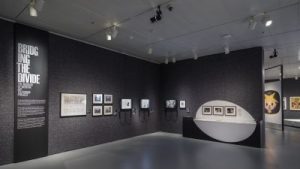
The Museum of Modern Art Television Project was established in 1952. The project was directed by the avant-garde filmmaker Sidney Peterson and Douglas MacAgy, a special consultant to the director of the museum. With the project, the nation’s preeminent arbiter of modern art and design embraced the creative potential of the young medium. The museum served as a particularly important cultural venue for exploring its possibilities and social and cultural implications. A major impetus was to create lucid and dynamic programs about modern art, pitched to a broad television audience.
While the museum remained ambivalent about the aesthetics of television, it nevertheless continued to support the medium well after the Television Project disbanded in 1955. In 1962 it organized Television U.S.A.: 13 Seasons, a retrospective of Golden Age programs as well as television commercials. Five years later, it established the Television Archive of the Arts, a collection of TV programs about modern art and ideas.
The Television Project challenged an abiding cultural myth: that TV was the opposite of high art in terms of quality and content. The project was consistent with the mission of the Museum of Modern Art, an institution that from its inception actively worked to expand the definition of modern art. A series of inventive exhibitions in the fifties and sixties embraced a range of topics in material culture, far beyond the traditional categories of painting, photography, and sculpture.
(Above) installation view, Revolution of the Eye, The Jewish Museum, New York, May 2015. Photo by David Heald, courtesy of the Jewish Museum
(Excerpt) Museum of Modern Art Television Project and NBC, co-producers United Productions of America Animator, The Invisible Moustache of Raoul Dufy, 1955. Color 35mm film with sound
In 1955 Sidney Peterson, co-director of the Television Project, conceived and wrote a special for children, The Invisible Moustache of Raoul Dufy. He negotiated a production deal among the museum, NBC, and United Productions of America (UPA), a major Hollywood animation studio. Dissatisfied with the film—and other programs and productions—the museum discontinued its Television Project later that year.
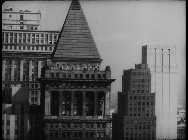
Screen capture, Sidney Peterson, director, Architectural Millinery, 1952. Produced for the Museum of Modern Art. Black-and-white 35mm film with sound
Under the auspices of the Television Project, Sidney Peterson produced Architectural Millinery, the first of a proposed series of short experimental commercial films for television. It looked at the abstract and formal similarities between hats and rooftops in the urban landscape. The Museum of Modern Art ultimately rejected the film for broadcast, concluding that it lowered the institution’s “intellectual level.”
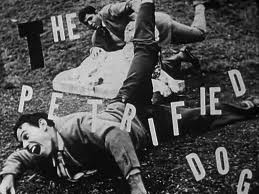
Screen capture, Sidney Peterson, director, The Petrified Dog, 1948. Black-and-white film with sound
Sidney Peterson was an author, artist, and filmmaker. From 1947 to 1950 he directed a series of Surrealist films that made a considerable impact on a burgeoning American avant-garde cinema. The Petrified Dog, produced under the auspices of Workshop 20, a film collective founded by Peterson at the California School of Fine Arts, resonates with surreal sight gags and formal experimentation.
WATCH: Sidney Peterson,The Petrified Dog, 1948
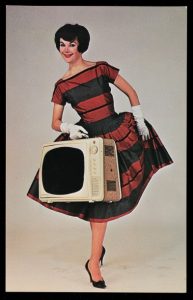
Publicity photograph for the Electrohome Courier portable television, late 1950s
The Television Project chiefly addressed female viewers, as the cultural historian Lynn Spigel has noted, embracing Peterson’s notion that men “were not a significant audience for arts programming” and that women were more open to being educated about art and more tolerant of cutting-edge aesthetics. (This was in striking contrast to the decidedly masculine interpretation of modernism visible in the museum’s painting and sculpture galleries.)
The Museum of Modern Art: Television Project and Beyond
The Museum of Modern Art engaged television both within the context of the Television Project and after it was disbanded. During the project’s three-year run, the museum corresponded with the networks as well as other museums, actively exploring ways to use TV in the service of modern art and ideas. In July 1948, even before the project began, the publicity secretary of the Museum of Modern Art received a letter from Ethel Hoffman, publicity secretary of the Albright Art Gallery, to, regarding “values of television as a publicity medium.” In 1962 the museum organized its groundbreaking exhibition Television U.S.A.: 13 Seasons. Ben Shahn was commissioned to design the accompanying poster and catalogue. The exhibition argued that television could be divided into two camps: one driven by profit, the other by artistic excellence, the latter the focus of the show.
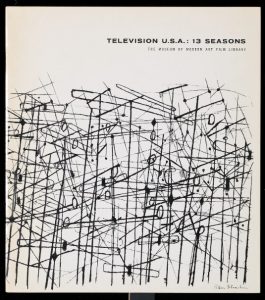
Ben Shahn, cover art for Television U.S.A.: 13 Seasons, The Museum of Modern Art, 1962. Private collection
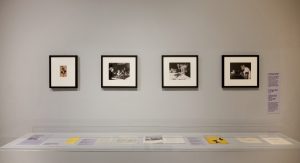
Installation view, Revolution of the Eye, NSU Art Museum, Fort Lauderdale, October 2015. Courtesy of NSU Art Museum: (second through forth photograph above vitrine), production stills, Through the Enchanted Gate, 1952: “Sound and Feeling of Weather,” September 12, 1952; “Under the Sea,” September 5, 1952; “In Touch with Your World,” September 19, 1952
In 1952 Through the Enchanted Gate, a television series that taught and encouraged children to make art, was created by Victor D’Amico, director of education at the Museum of Modern Art, and produced by the museum in collaboration with WNBC-NBT. The well-regarded program offered “any child within range of a television the best art training possible.”